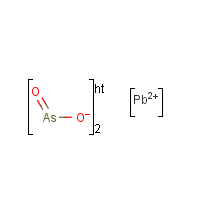Lead(II) arsenite
Agent Name
Lead(II) arsenite
CAS Number
10031-13-7
Formula
As2-O4.Pb
Major Category
Metals

Synonyms
Arsenenous acid, lead(2+) salt; Lead arsenite; [ChemIDplus] UN1618
Category
Lead Compounds, Inorganic
Description
White solid; Insoluble in water; [Merck Index]
Sources/Uses
Used as an insecticide; [Merck Index]
Comments
A skin, eye, and respiratory tract irritant; May cause severe gastroenteritis, pigmentation disorders, nasal septum perforation, anemia, cardiac disorders, neuropathy, liver injury, and kidney injury; A human carcinogen and reproductive toxicant; [ICSC] See "Arsenic" and the linked occupational diseases. See "Lead" and the linked occupational diseases.
Biomedical References
Exposure Assessment
BEI
Lead in blood = 200 ug/L (20 ug/100 ml); sampling time not critical; Inorganic arsenic plus methylated metabolites in urine = 35 ug As/L; end of workweek; [ACGIH]
TLV (ACGIH)
0.05 mg/m3, as Pb (0.01 mg/m3, as As)
PEL (OSHA)
0.05 mg/m3, as Pb (0.01 mg/m3, as As)
IDLH (NIOSH)
5 mg/m3, as As
Explanatory Notes
The Guide in the Emergency Response Guidebook is for "Lead arsenites."
Adverse Effects
Anemia
Aplastic anemia
Neurotoxin
Sensorimotor
Hepatotoxin
Hepatoxic (a) from occupational exposure (secondary effect) or (b) in animal studies or in humans after ingestion
Nephrotoxin
Yes
Reproductive Toxin
Yes
IARC Carcinogen
Probable (2a)
NTP Carcinogen
Anticipated human carcinogen
ACGIH Carcinogen
Confirmed Animal
Diseases, Processes, and Activities Linked to This Agent
Processes
Industrial Processes with risk of exposure: